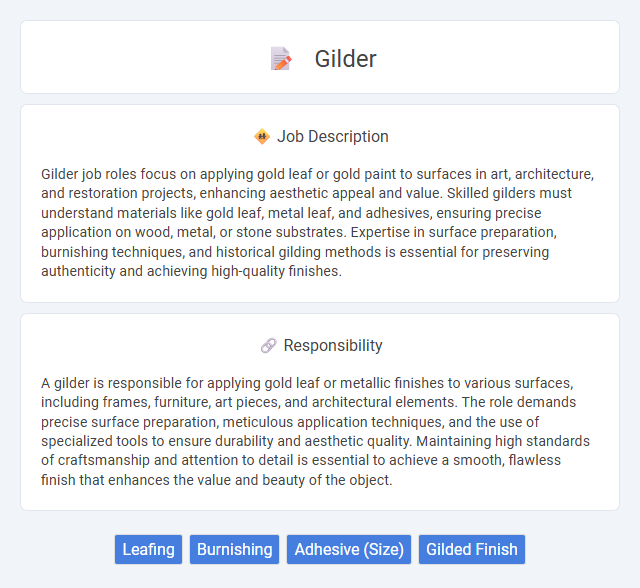
Gilder job roles focus on applying gold leaf or gold paint to surfaces in art, architecture, and restoration projects, enhancing aesthetic appeal and value. Skilled gilders must understand materials like gold leaf, metal leaf, and adhesives, ensuring precise application on wood, metal, or stone substrates. Expertise in surface preparation, burnishing techniques, and historical gilding methods is essential for preserving authenticity and achieving high-quality finishes.
Gilder jobs likely suit individuals with steady hands, keen attention to detail, and patience, as the work involves applying delicate gold leaf or foil to surfaces. People who thrive in calm, focused environments and possess fine motor skills probably find this occupation fitting. Those uncomfortable with repetitive tasks or lacking precision may struggle with the demands of gilding.
Qualification
Gilders require precision and expertise in applying gold leaf or metal foils to various surfaces, often necessitating training in decorative arts or metalworking. Proficiency in handling delicate materials, knowledge of surface preparation techniques, and steady hand coordination are critical for achieving high-quality finishes. Many employers prefer candidates with experience in restoration projects or certifications in fine art or artisan crafts to ensure detail-oriented craftsmanship.
Responsibility
A gilder is responsible for applying gold leaf or metallic finishes to various surfaces, including frames, furniture, art pieces, and architectural elements. The role demands precise surface preparation, meticulous application techniques, and the use of specialized tools to ensure durability and aesthetic quality. Maintaining high standards of craftsmanship and attention to detail is essential to achieve a smooth, flawless finish that enhances the value and beauty of the object.
Benefit
Gilder jobs often provide a unique opportunity to work with high-value materials, potentially leading to increased earning potential. The demand for skilled gilders could contribute to job stability and the chance to develop specialized craftsmanship. Benefits may include working in creative environments and the satisfaction of preserving or enhancing artistic and architectural pieces.
Challenge
Gilders may face the challenge of working with delicate materials that require precision and steady hands, increasing the likelihood of errors during application. The probability of encountering time-consuming tasks or adjustments is high, given that gilding often involves intricate patterns and surfaces. Meeting client expectations for flawless finishes can also present a demanding aspect of the job, as even minor imperfections could impact overall satisfaction.
Career Advancement
Gilders can advance their careers by gaining expertise in high-demand industries such as furniture restoration, architectural detailing, and fine arts. Mastering advanced gilding techniques and adopting new materials or technologies often leads to supervisory or project management roles. Continuous professional development, including certifications and portfolio building, enhances job prospects and earning potential within the decorative arts sector.
Key Terms
Leafing
A gilder specializes in applying thin sheets of gold leaf or metal leaf to surfaces, a meticulous process known as leafing that enhances furniture, artwork, and architectural details with a lustrous finish. Techniques such as water gilding and oil gilding allow the gilder to achieve different textures and durability levels, often requiring precise hand tools and expertise in adhesion methods. Mastery in leafing demands an understanding of surface preparation, handling delicate gold leaf sheets, and ensuring smooth, seamless application for a flawless decorative effect.
Burnishing
Gilders specialize in applying fine metal leaf to surfaces, with burnishing playing a critical role in ensuring smooth, reflective finishes by pressing and polishing the gold or metal leaf onto the substrate. Burnishing tools, often agate stones, are used to compress the metal leaf, enhancing its adhesion and increasing the brilliance and durability of the gilded surface. Precise burnishing techniques contribute to the depth, shine, and protective qualities essential in both decorative and restoration gilding projects.
Adhesive (Size)
A gilder's adhesive, commonly referred to as "size," is a key substance used to prepare surfaces for gold leaf application, ensuring optimal adhesion and durability. Traditional sizes include oil-based and water-based formulas, each chosen based on the substrate and intended finish, with oil size typically requiring a drying period for tackiness. Proper application of size enhances the gilding process by providing a smooth, tacky layer that securely bonds delicate gold leaf to wood, metal, or canvas surfaces.
Gilded Finish
A gilder specializes in applying a gilded finish, which involves the meticulous process of layering thin sheets of gold leaf or metallic foil onto surfaces for decorative purposes. This gilded finish enhances the visual appeal and value of objects such as picture frames, furniture, and architectural elements by providing a rich, reflective gold appearance. Mastery in surface preparation and gold leaf application techniques is essential for achieving a flawless and enduring gilded finish.
 kuljobs.com
kuljobs.com